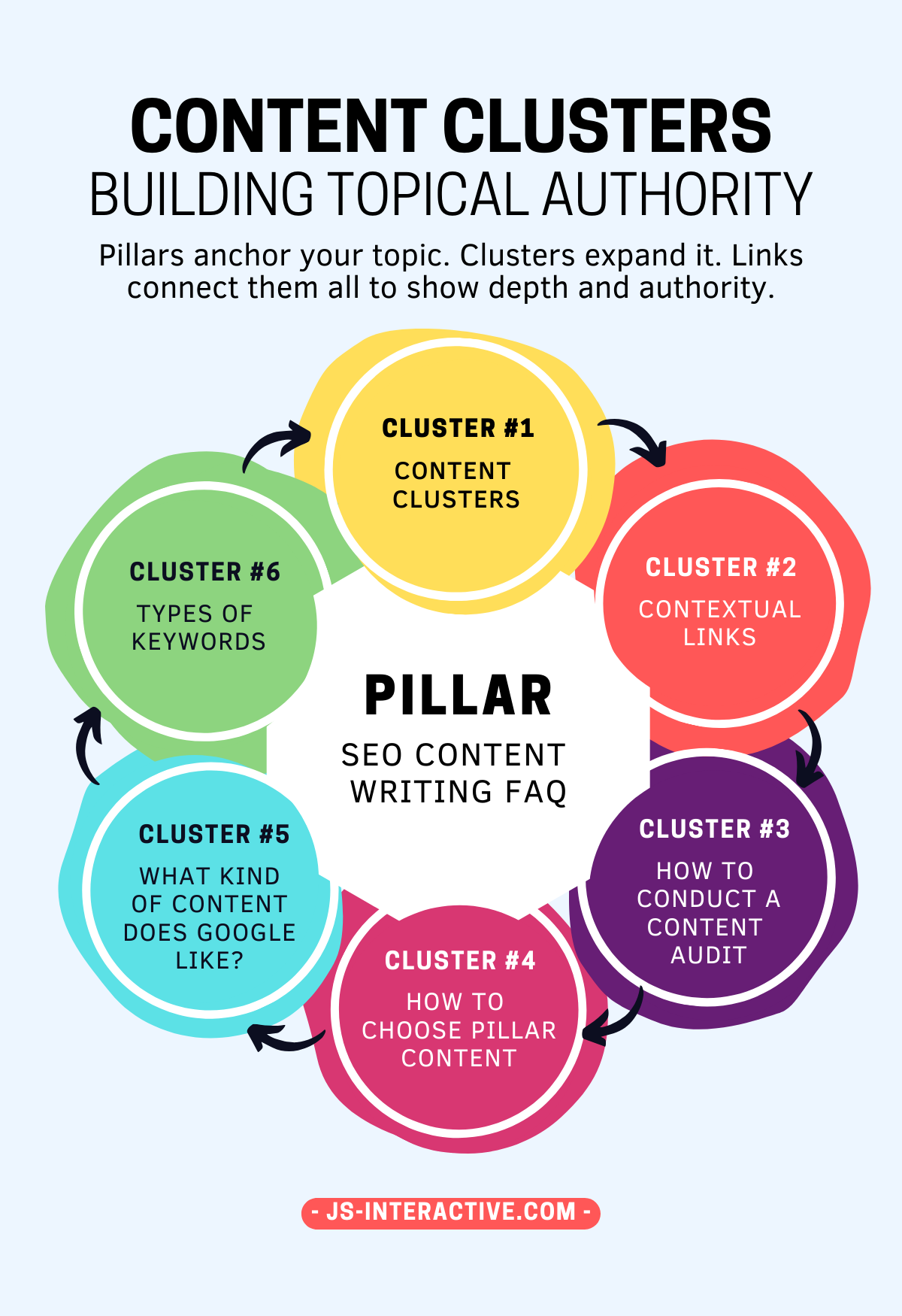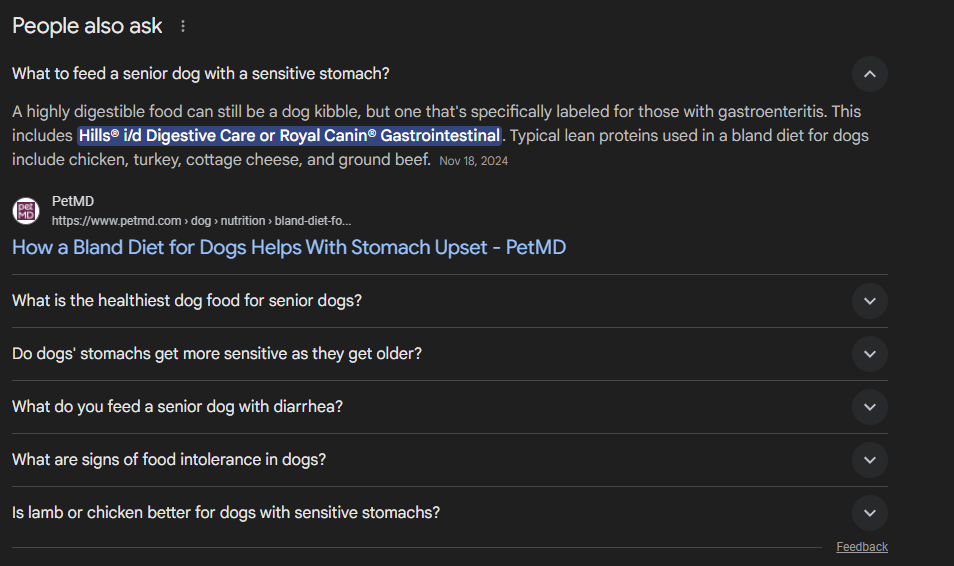Increase Visibility in AI Search using Google’s Query Fan-Out Technique
My dog Abby has always had food sensitivities.
After years of trial and error, we’ve found foods that work.
Now that Abby is turning eleven, I wanted to switch her to a senior formula. So I searched for the best senior dog food options.

What I expected from my search? A straightforward list of brands.
What I got in return was a set of results from Google that branched into much more:
- Advice on joint health
- Comparisons of ingredients
- Tips on digestion, and
- Feeding guidance for older dogs
Google wasn’t just answering my question — it was anticipating the follow-ups.
This shift reveals a great deal about how search works today.
A single phrase no longer pulls up results for one keyword alone. Google looks for context, pulling together answers that reflect the broader intent behind the query. And that has big consequences for how we think about content.
Why Context is the New King
What happened when I searched for Abby’s food reflects a larger change in how Google processes information.
Instead of matching my exact phrase to a list of pages, Google now breaks that query into smaller, related questions and builds a more complete answer.
For businesses, this means old-school keyword targeting doesn’t carry the same weight it once did. A single blog post optimized for a single phrase won’t stand out when Google is considering the bigger picture.
The algorithm prioritizes context, evaluating how well your content connects related ideas, anticipates follow-up questions, and demonstrates authority on a topic.
Put simply, content that exists in isolation tends to get ignored.
Content that builds connections gets visibility.
This shift doesn’t happen by accident. Google uses a method that expands one search into many smaller ones, then combines the answers into a single result.
Understanding how that process works is key to creating content that gets included.
How the Query Fan-Out Technique Works
So what exactly is happening behind the scenes?
Google’s AI mode applies what’s known as the query fan-out technique. Instead of treating your search as one isolated request, it breaks that query into multiple smaller questions, each targeting a different part of the intent.
Take the example of “how to improve website performance.” Rather than stopping at one angle, Google fans that query out into related areas such as:
- Speed – site load times and image compression
- User experience – navigation, accessibility, design
- Core Web Vitals – LCP, CLS, FID, INP
- Caching strategies – browser caching, preloading
- Hosting options – shared, VPS, or cloud providers
Google’s goal is to satisfy the user’s search request within a single session. This involves pulling insights from smaller searches and synthesizing them into a comprehensive answer.
This mirrors how people search in practice. As Kevin Indig has shown in his research on query refinements, users rarely stop with a single search. They adjust wording, add context, and chase down related questions until they get the clarity they need.
Query fan-out takes that same behavior and bakes it into the system, delivering a fuller response without waiting for the user to refine.
For content creators, that means the opportunity has shifted.
You’re not just competing to rank for a single keyword. You’re competing to provide the clearest, most relevant answers to the many sub-questions Google is asking on the user’s behalf.
What Content Creators Stand to Gain
At first glance, query fan-out might feel like it makes things harder. If Google is pulling from dozens of angles at once, how can one piece of content stand out?
The reality is that this shift actually opens new opportunities for creators who focus on depth and relevance.
- Visibility in AI answers. Content that thoroughly covers subtopics has a higher chance of being included in AI-generated summaries. Even if a user does not click, your brand name can appear as a cited source and build trust and recognition.
- More valuable traffic. The people who click through from AI answers tend to be further along in their research. They are not looking for surface-level definitions. They want depth, examples, and proof, which makes them more likely to engage.
- Authority through originality. Google favors content that demonstrates expertise and trustworthiness. Adding unique insights, data, or firsthand experience helps your content rise above generic answers and get picked up in the fan-out process.
- Alignment with real user behavior. People naturally ask follow-up questions. By anticipating those questions in your content, you are not only helping readers but also aligning with the way Google now structures search.
When done correctly, query fan-out does not push creators out of the process; instead, it rewards those who build context and authority into their content.
6 Steps to Strengthen Content Visibility with Query Fan-Out
Creating strong content is no longer about chasing a single keyword. What matters is depth and context that show Google your site can answer the many related questions behind every search. The steps below outline a practical way to structure content so it aligns with how search works today.
1. Understand Your Audience
Every strong content strategy starts with the people you want to reach. Search engines may expand queries into sub-questions, but those questions still reflect real needs and concerns. If you don’t know what your audience cares about, your content will likely miss the mark.
Understanding your audience goes beyond demographics. It means recognizing how their needs change depending on where they are in their journey:
- Awareness stage: Someone just beginning research will ask broad questions. For Abby’s food, it might be “What is the best senior dog food?”
- Consideration stage: As they narrow options, the questions get more specific, such as “senior dog food for sensitive stomachs” or “grain-free formulas for older dogs.”
- Decision stage: Closer to action, queries shift to comparisons, reviews, or pricing: “Royal Canin vs Hill’s Science Diet for senior dogs.”
The same pattern shows up in every industry. If you only create content for one stage, you miss the chance to stay visible when users refine their search. Query fan-out builds these stages into the results, pulling sub-questions from different points in the journey.
To be included, your content must remain relevant across all of them.
- Define who you want to reach and what problems they are trying to solve.
- Use surveys, interviews, and analytics to uncover what they search for at different stages.
- Keep your content hyper-relevant by tying every piece back to their needs, whether they are just exploring or ready to buy.
When you map your content to the audience journey, you not only help people find what they need but also align with the way Google now interprets queries.
2. Start with Pillars, Add Clusters
One article is rarely enough to cover a topic in full. To align with query fan-out, your content needs a structure that shows depth and connection.
Think of it as a hub-and-spoke model:
- The pillar page sits at the center, covering the core topic in broad detail.
- Cluster content surrounds the pillar, each piece addressing a subtopic in greater depth.
- Internal links connect the clusters to the pillar and to each other, showing both readers and search engines how the topics fit together.
A pillar on “SEO Content Writing FAQ” is supported by clusters on related subtopics such as choosing pillar content, conducting audits, contextual linking, and keyword types. Together, they create a content ecosystem that mirrors the way Google fans out a single query into multiple smaller ones.
When you build content this way, you are not just publishing isolated posts. You are creating a framework that signals topical authority, and that is exactly what Google rewards in AI-driven results.

3. Answer the Next Question
Strong content does more than answer the first query. It anticipates the follow-ups a reader will naturally ask. If someone searches for senior dog food, they may also want to know about portion sizes, ingredients for sensitive stomachs, or how one brand compares to another.
Addressing these connected questions or linking to related articles offers readers a fuller experience and boosts the chances of your content being included in Google’s AI-generated answers.
You can spot these follow-up questions in places like Google’s People Also Ask, community forums, or even your own site analytics.

4. Write for Both Humans and Machines
Your content now has two audiences. It needs to be easy for people to read and easy for search engines to parse when they assemble AI-driven answers.
For readers, clarity and flow matter. Keep sentences short and paragraphs focused. Use headings that clearly state the question you are answering. Organize details with lists or tables when it makes the content easier to scan.
According to a 2023 study by Adsy, people often read only 20 to 28% of a page’s content before deciding whether to stay or leave. This means strong structure and formatting are not optional; they are what keep readers engaged.
For machines, precision is key. Search engines need clear signals to identify and extract the answer to a sub-query. Content that is divided into well-labeled sections with direct answers has a better chance of being included in AI summaries. Schema markup can also provide extra context that reinforces what your content covers.
When you write with both audiences in mind, you make your content easier to read and easier to surface. This balance is what keeps your work visible in a search landscape where AI is synthesizing information from multiple sources.
5. Prove You Know Your Stuff
Google’s AI is designed to favor content that demonstrates expertise and trustworthiness. Generic advice gets lost in the mix, while original, authoritative insights stand out.
You can strengthen your content by:
- Adding unique data, examples, or firsthand experience that no one else can provide.
- Citing credible sources that back up your claims.
- Keeping your content updated so it reflects the latest information.
- Including author bios or context that highlight real-world expertise.
These signals align with Google’s E-E-A-T framework: experience, expertise, authoritativeness, and trustworthiness. The more you show proof behind your content, the more likely it is to be pulled into AI-driven answers.
6. Keep SEO Fundamentals Strong
Even though content matters more than ever, the basics of SEO remain essential. If your site is slow or hard to crawl, Google may overlook it no matter how good your writing is.
Here are key areas to focus on:
- Make sure your site loads quickly and works well on mobile.
- Keep your site architecture clean so both users and search engines can navigate easily.
- Check that all important content is indexable and not blocked by technical errors.
According to a 2025 report by WP Rocket, 40% of visitors will abandon a site that takes more than three seconds to load on mobile.
Fast loading and technical hygiene make your content easier to find and easier to use. They also build trust, which increases the chances your content will be included when Google pulls answers together using query fan-out.
Finding the Subtopics That Matter
Query fan-out illustrates the extent to which a single search can encompass. To keep up, you need to know which subtopics Google is most likely to surface and which ones your audience cares about.
Tools like Google’s People Also Ask, AlsoAsked, and Answer the Public reveal the follow-up questions people are already searching for. Platforms such as Semrush or Ahrefs help identify related keywords and uncover content gaps.

Community conversations are just as useful. Reddit threads, Quora questions, and niche groups often show what real people are asking in their own words. Your site analytics can also highlight the searches and on-site queries your audience makes most often.
Mapping these subtopics creates a blueprint that mirrors the way Google breaks down queries. The more relevant and complete your coverage, the more likely your content will surface in AI-driven search results.
Context Wins in AI Search, and JS Interactive Can Show You How
Content that covers only one angle gets left behind. Content that creates context by answering the next question, connecting related ideas, and showing real expertise is what surfaces in AI-driven results.
Now is the time to look at your site with fresh eyes. Does it provide a single post on a topic, or does it build the kind of connected framework that Google recognizes as authoritative?
JS Interactive helps businesses create strategies that do more than rank. We build content ecosystems that earn visibility, trust, and long-term results.
Contact us today to schedule your consultation!